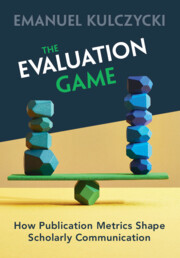Book contents
- The Evaluation Game
- The Evaluation Game
- Copyright page
- Contents
- Acknowledgments
- Introduction
- 1 Evaluation as Power
- 2 Economization and Metricization
- 3 Untold Histories of Research Evaluation
- 4 The Diversity of Evaluative Powers
- 5 Players and the Stakes
- 6 Playing the Evaluation Game
- Conclusions
- References
- Index
6 - Playing the Evaluation Game
Published online by Cambridge University Press: 21 April 2023
- The Evaluation Game
- The Evaluation Game
- Copyright page
- Contents
- Acknowledgments
- Introduction
- 1 Evaluation as Power
- 2 Economization and Metricization
- 3 Untold Histories of Research Evaluation
- 4 The Diversity of Evaluative Powers
- 5 Players and the Stakes
- 6 Playing the Evaluation Game
- Conclusions
- References
- Index
Summary
Chapter 6 deals with the main areas in which the evaluation game transforms scholarly communication practices. Thus, it focuses on the obsession with metrics as a quantification of every aspect of academic labor; so-called questionable academia, that is the massive expansion of questionable publishers, journals, and conferences; following the metrics deployed by institutions, and changes in publication patterns in terms of publication types, the local or global orientation of research, its contents, and the dominant languages of publications. Finally, the chapter underlines the importance of taking a geopolitically sensitive approach to evaluation games that is able to account for differences in the ways in which the game is played in central versus peripheral countries, as well as in the ways in which such practices are valorized, depending on the location of a given science system. Such differences are not only the result of differential access to resources and shifting power relations but also, as argued in the book, of the historical heritage of capitalist or socialist models in specific countries and institutions.
Keywords
- Type
- Chapter
- Information
- The Evaluation GameHow Publication Metrics Shape Scholarly Communication, pp. 157 - 181Publisher: Cambridge University PressPrint publication year: 2023
- 1
- Cited by

